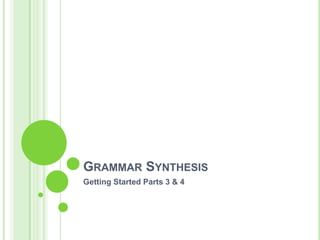
Gs 3 4 Grammar Synthesis
- 1. Grammar Synthesis Getting Started Parts 3 & 4
- 2. (1) What does particle は do? Give an example. 「は」is the Topic Marker TOPIC わたし は すしが すきです。 TOPIC トムさん は よく すしを たべます。
- 3. (2) What does particle を do? Give an example. 「を」is the Direct Object Marker OBJ わたし は えいが を みます。 OBJ トムさん は よく すし を たべます。
- 4. (3) What does particle へdo? Give an example. 「へ」is the Directional Marker Destination わたし は えいが へ いきます。 トムさん は うち へ かえります。 Destination
- 5. (4) What’s the word order for in a typical sentence? Mark the topic of the sentence & the verb phrase. TOPIC わたし は おんがく を ききます。 Verb Phrase
- 6. 5) When we’re talking about a specific time (e.g., at 8:00) which particle do we use? 8:00 に Specific Time “AT”
- 7. (6) When we want to say “around 8:00”, which particle do we use? 8:00 ごろ Specific Time “AROUND”
- 8. (7) When we want to say “from 8:00 to 9:00”, which particles do we use? 8:00 から 9:00 まで Specific Time Specific Time “FROM” “UNTIL”
- 9. (8) What are the frequency words we’ve learned? まいにち よく ときどき あまり+Neg ぜんぜん+Neg いちにちじゅう
- 10. (9) Where does the frequency word go in a sentence? Show by example. Write the sentence: I don’t drink coffee at all. TOPIC わたしは ぜんぜん コーヒーをのみません。 Verb Phrase Frequency
- 11. (10) Fill in the correct particles below: は に で と Topic___ 00:00___Person___ Place___ VP
- 12. Can you change the word order in the sentence above? If so, what are the rules? は に で と Topic___ 00:00___Person___ Place___ VP
- 13. 11) Fill in the verb conjugation chart below: ききません ききません でした ききました
- 14. (12) What form do we use to make an invitation? Give an example. V-ません+か (いっしょに)ひるごはん を たべませんか。
- 17. (15) Likes and dislikes. Write the Japanese words below. Given an example sentence for each word: like = わたし は すし が すき です。 don’t like = わたし は さしみ が すきじゃありません。 strong dislike = わたし は なっとう が きらい です。 like the best = わたし は アイス が いちばん すき です。 especially = とくに、チョコレート が すき です。
- 18. Fill in the correct particles for the following sentence pattern: Topic ____ Object ____ sukidesu. は が
- 19. (16) Do you need to put a particle after a relative time word (e.g., today, tomorrow, and yesterday)? If so, which particle do you use? いいえ
- 20. (17) What are some expressions that we use when talking about the weather? It’s terrible weather, isn’t it? = ひどい おてんき ですね。 It’s nice weather, isn’t it? = いい おてんき ですね。 It’s raining hard, isn’t it? = ひどい あめ ですね。 Today’s warm, isn’t it? = きょう は あたたかい ですね。 Today’s cool, isn’t it? = きょう は すずしい ですね。
- 21. おめでとう! Congratulations! You’ve worked so hard! これからも、がんばりましょう!Let’s continue to do so!